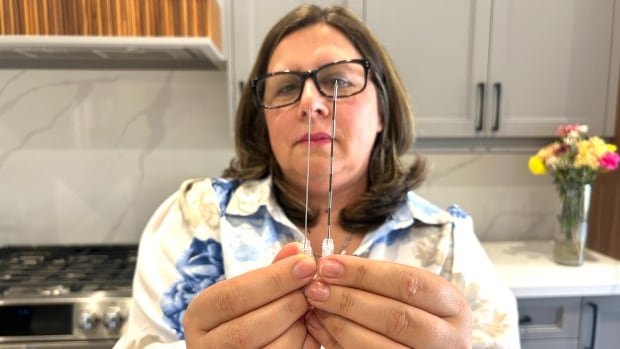Giovanna Ippolito is living with a broken needle in her spine after it broke off during childbirth. An anesthesiologist then left the four centimetre-long fragment embedded in her back — and didn’t tell her what happened.
Instead, it was discovered during an X-ray more than a decade later. The Bolton, Ont., woman says her doctor can’t directly link the pain she’s experiencing to the needle, but one thing has been made clear to her: it’s not safe to remove it.
The location and the scar tissue that has grown around the needle make it too dangerous.
Exactly when the needle was left there is unclear because medical staff failed to note it in her records — but Ippolito says she’s only had needles inserted into her back on two occasions — during the birth of her son in 2002 and her daughter in 2004.

She says for years she’s been living with pain in her shoulders and right leg.
Both births took place at Mackenzie Richmond Hill Hospital (called York Central Hospital at the time), north of Toronto.
After botched investigations and many years, no one may ever be held accountable.
“It infuriates me. The pain is here to stay,” Ippolito told Go Public. “Somebody made a mistake many years ago… now they need to be accountable for it.”
Go Public first told Ippolito’s story in 2020. Since then, she is no closer to finding out who did it — despite pursuing almost every complaint avenue available to patients injured by the medical system.
Last year, nearly 175,000 patients suffered potentially preventable medical harm while in hospital, according to the Canadian Institute for Health Information (CIHI).
An Ontario mother is fighting for answers more than two decades after a needle was left in her spine during childbirth. Several botched investigations later, Giovanna Ippolito worries no one may ever be held accountable.
That number has increased over the past three years from 168,000 in 2022 and 157,000 the year before that.
Like Ippolito, patients who file complaints after being hurt by the medical system are often left “in the dark about what happened to them,” said Toronto-based medical malpractice lawyer Jeremy Syrtash.
He is not directly involved in Ippolito’s complaint.

“I’ve seen this many times,” said Syrtash. “A patient will come to me and say harm happened, I will get the medical records and there would be no documentation to confirm that… and because they didn’t document that error, [patients are] told, ‘Oh, well, you know, there’s nothing we can do.'”
Key question ignored
Ippolito was repeatedly told that because whichever anesthesiologist left the needle in her spine didn’t note it in her medical records, no one could be identified as the one responsible.
According to professional and ethical codes of conduct, doctors are obligated to tell patients when medical errors cause harm.
Experts say it’s impossible the doctor in question didn’t know about the fragment.
Ippolito says hospital officials flatly refused to look at the X-ray showing the needle and made no effort to properly investigate her complaint.

In 2022, after filing a Freedom of Information Request, Ippolito found out what the hospital did with her complaint.
“I got all the emails pertaining to my case… The documents don’t lie. The emails don’t lie. There was no [record of an] investigation,” she said.
When Go Public asked about that, the hospital cited privacy and confidentiality, despite Ippolito having given it her written permission to speak openly about her case.
She went to Ontario’s Patient Ombudsman for help. It found “unfairness and deficiencies” in Mackenzie’s Health’s patient complaint process, but doesn’t have the authority to force the hospital to take any action.
Botched investigations
The College of Physicians and Surgeons of Ontario neglected to get an independent expert to try to identify what kind of needle is in Ippolito’s spine when she filed complaints against both doctors involved in her births.
That’s key information that might identify the doctor responsible.

Her son’s birth required an epidural and a spinal block, and her daughter’s birth required an epidural only — two different types of needles.
Instead, the college cleared both doctors in May 2022, saying it lacked any information that the care she received was inappropriate.
“There’s no due diligence,” Ippolito said. “Nobody in this panel thought to say, ‘Hey, if we narrow down the needle, we’ll narrow down who it is’… [instead] the college came back clearing both doctors, citing again that this was not in my records.”
In March, the college was reprimanded for doing “inadequate” investigations into her case by the Ontario’s Health Professions Appeal and Review Board (HPARB).
The review board found the college failed to “obtain the essential relevant information” about the case and ordered it to re-investigate.
Ippolito is still waiting for the results.

Over the past five years, the HPARB says it has reviewed 1,747 college cases and sent 104 back to be re-investigated, a rate of about six per cent.
The college did not answer Go Public’s questions about Ippolito’s case, citing “confidentiality restrictions” of “several parties” involved.
Instead, it said in an email, “this specific issue will be investigated thoroughly and expeditiously with the goal of ensuring that the patient feels safe, supported and confident in the accountability of their care providers.”
Power imbalance
Syrtash says provincial patient complaint systems can leave injured patients at a disadvantage.
He says that’s partly because all the information about what happened to a patient is in the hands of medical professionals — who could be defendants in a potential lawsuit — leading to “a real power imbalance” where patients can’t get the answers.
Further, doctors who are the focus of patient complaints can access free legal advice through the Canadian Medical Protective Association (CMPA) — mostly paid for by taxpayers.
Both doctors in Ippolito’s case did have legal counsel, according to review board documents.
Go Public asked the CMPA if it paid for that legal advice, but it didn’t answer the question.
“This woman was just trying to get information and she’s already up against a system where [doctors] most likely have a lawyer to respond to her complaint,” said Syrtash.
Ippolito says she has days when she wants to give up — but refuses until she gets the answers she’s seeking.
“It’s taken almost six years of my life,” since the needle was first discovered, she said.
“I continue to fight because I want the answers, I want the change. I don’t want anyone to go through this.”
Submit your story ideas
Go Public is an investigative news segment on CBC-TV, radio and the web.
We tell your stories, shed light on wrongdoing and hold the powers that be accountable.
If you have a story in the public interest, or if you’re an insider with information, contact gopublic@cbc.ca with your name, contact information and a brief summary. All emails are confidential until you decide to Go Public.
Read more stories by Go Public.
Read about our hosts.










